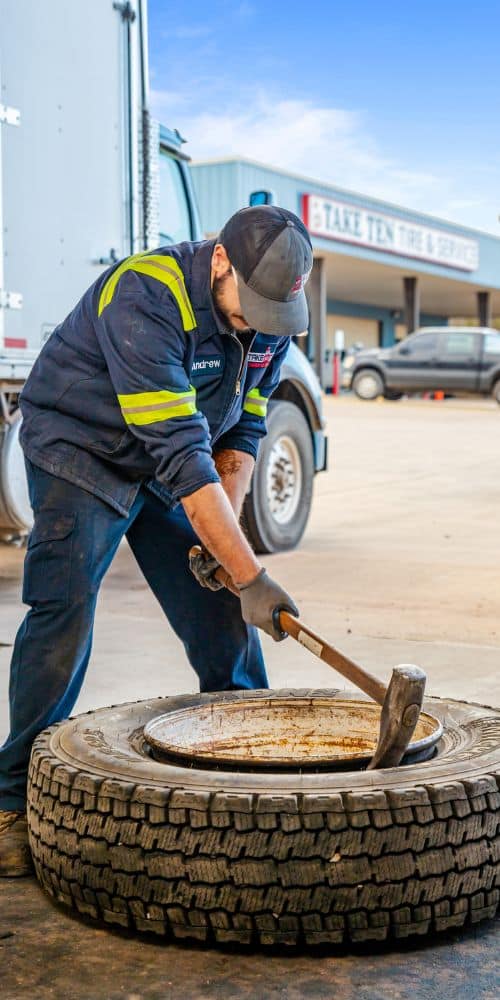Unlock Efficiency: Specialist GMC Tire Service at Morris Tires
Unlock Efficiency: Specialist GMC Tire Service at Morris Tires
Blog Article
Tire Solution: The Influence of Climate Condition
When it comes to making sure optimum efficiency and safety and security on the roadway, recognizing the influence of weather condition conditions on tire solution is crucial. From scorching warmth to icy roads, each weather component can considerably influence tire functionality and overall driving experience. By diving right into the results of differing climate condition on tires, motorists can get valuable insights that may improve their car's efficiency and durability. In this discussion, we will certainly discover the complex relationship in between weather problems and tire service, shedding light on the value of weather-specific tire maintenance practices and considerations.
Warmth and Tire Performance
When subjected to heats, tires experience modifications in performance that can dramatically impact car security and handling. The warmth produced from long term driving or heat conditions causes the tire rubber to soften, causing decreased step life and increased wear. As the rubber comes to be softer, the tire's hold when driving diminishes, impacting stopping distances and general traction. In severe instances, extreme heat can even create tire blowouts, positioning a serious safety risk to the lorry and its occupants.

Winter Results
Cold weather condition problems can have a considerable impact on tire efficiency and security. In chilly weather, tires may likewise shed air stress extra quickly, which can influence taking care of and fuel performance.
To minimize the effects of winter on tires, it is crucial to frequently examine tire stress and inflate them to the producer's suggested degrees. Utilizing winter months or all-season tires made for cold climate problems can likewise enhance grip and hold on icy or snowy roads. Proper tire upkeep, consisting of routine examinations for wear and damages, ends up being a lot more important throughout cooler months to guarantee optimal performance and safety and security.
Rainy Conditions Impact
Tires with damaged treads are much more prone to hydroplaning, where a layer of water constructs up in between the tire and the roadway surface area, leading to loss of grip. To combat this, vehicle drivers need to consistently check their tires for sufficient tread depth and think about investing in tires especially created for damp conditions.
Additionally, rainy weather condition can additionally reduce visibility, making it testing for motorists to see the road in advance clearly (GMC Tire Service). In such conditions, it is necessary to adjust driving rates appropriately and maintain a risk-free complying with range to permit for unexpected stops. Correctly filled with air tires can also help in keeping control on wet roadways by providing better handling and grip
Snow and Tire Security
Snow-covered roadways present distinct difficulties for chauffeurs, stressing the value of proper tire selection and upkeep. When driving in snowy problems, having the right tires can make a considerable difference in safety and efficiency. Winter months tires are developed with unique rubber compounds and step patterns to supply far better grip on snow and ice compared to look at this site all-season tires. The deeper treads and sipes of winter tires aid grip the road better, reducing the threat of sliding and slipping.

It is essential to follow maker guidelines when setting up and making use of tire chains to prevent damage to the tires and vehicle. By picking the appropriate tires, keeping correct rising cost of living, and taking into consideration extra traction help like tire chains, vehicle drivers can improve their safety and security when navigating snow-covered roads.
Weather-Related Tire Upkeep
When encountered with various climate conditions, correct tire maintenance ends up being an essential facet of car safety and efficiency. Weather-related tire upkeep incorporates a variety of techniques focused on ensuring ideal tire feature and durability in various weather situations. One key aspect of weather-related tire maintenance is tire stress policy. Changing temperatures can trigger tire pressure to differ, influencing traction and gas effectiveness. Frequently inspecting and readjusting tire stress according to manufacturer suggestions is important for safe driving in changing weather conditions. Furthermore, tire tread deepness plays a significant role in dealing with various weather condition components. Tires with adequate tread depth supply much better grasp on damp or icy roads, decreasing the threat of skidding or hydroplaning. Inspecting tire tread regularly and replacing tires when tread wear gets to a particular depth is crucial for maintaining grip and security in unfavorable climate. By prioritizing weather-related tire upkeep, motorists can improve safety and security, boost lorry efficiency, and prolong the lifespan of their tires.
Final Thought
Finally, weather have a considerable influence on tire performance and safety and security. From warmth impacting tire stress and use to winter reducing traction, it is vital to consider the weather when preserving and utilizing tires. Rainy over here conditions can lower grasp and bring about hydroplaning, while snow can raise the risk of mishaps if tires are not appropriately equipped. Weather-related tire upkeep is important in ensuring optimum efficiency and safety and a knockout post security on the roads.
In this discussion, we will certainly check out the intricate connection between climate conditions and tire solution, shedding light on the value of weather-specific tire maintenance practices and factors to consider.

Report this page